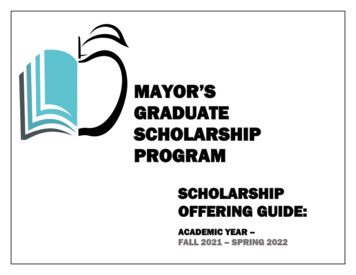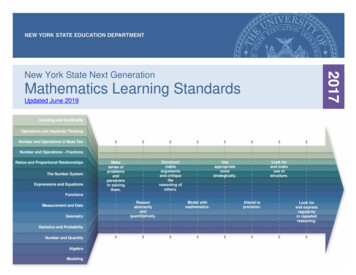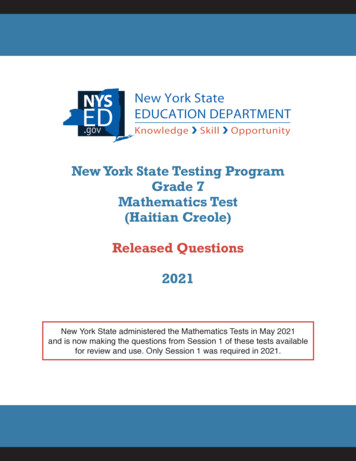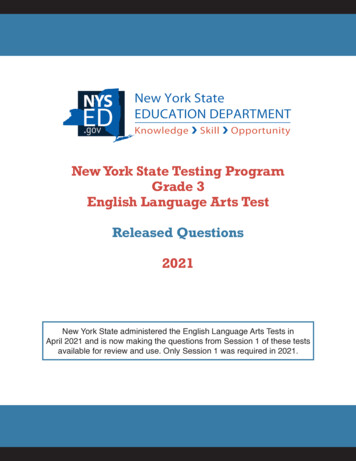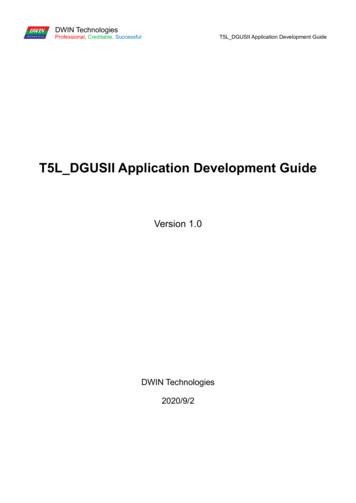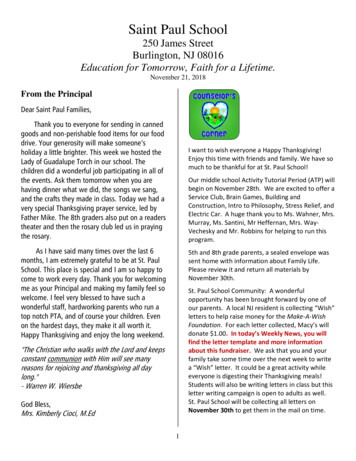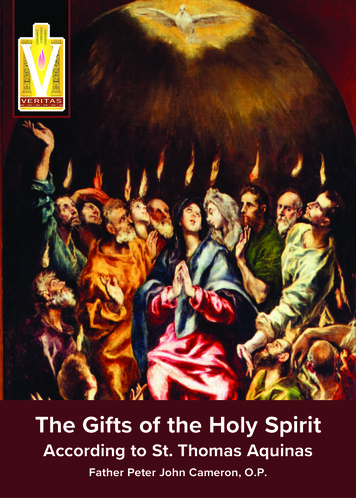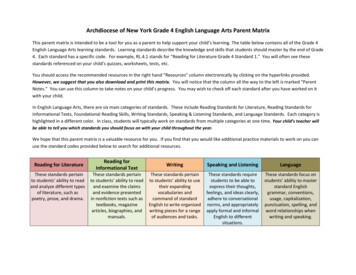
Transcription
Archdiocese of New York Grade 4 English Language Arts Parent MatrixThis parent matrix is intended to be a tool for you as a parent to help support your child’s learning. The table below contains all of the Grade 4English Language Arts learning standards. Learning standards describe the knowledge and skills that students should master by the end of Grade4. Each standard has a specific code. For example, RL.4.1 stands for “Reading for Literature Grade 4 Standard 1.” You will often see thesestandards referenced on your child’s quizzes, worksheets, tests, etc.You should access the recommended resources in the right hand “Resources” column electronically by clicking on the hyperlinks provided.However, we suggest that you also download and print this matrix. You will notice that the column all the way to the left is marked “ParentNotes.” You can use this column to take notes on your child’s progress. You may wish to check off each standard after you have worked on itwith your child.In English Language Arts, there are six main categories of standards. These include Reading Standards for Literature, Reading Standards forInformational Texts, Foundational Reading Skills, Writing Standards, Speaking & Listening Standards, and Language Standards. Each category ishighlighted in a different color. In class, students will typically work on standards from multiple categories at one time. Your child’s teacher willbe able to tell you which standards you should focus on with your child throughout the year.We hope that this parent matrix is a valuable resource for you. If you find that you would like additional practice materials to work on you canuse the standard codes provided below to search for additional resources.Reading for LiteratureThese standards pertainto students’ ability to readand analyze different typesof literature, such aspoetry, prose, and drama.Reading forInformational TextWritingSpeaking and ListeningLanguageThese standards pertainto students’ ability to readand examine the claimsand evidence presentedin nonfiction texts such astextbooks, magazinearticles, biographies, andmanuals.These standards pertainto students’ ability to usetheir expandingvocabularies andcommand of standardEnglish to write organizedwriting pieces for a rangeof audiences and tasks.These standards requirestudents to be able toexpress their thoughts,feelings, and ideas clearly,adhere to conversationalnorms, and appropriatelyapply formal and informalEnglish to differentsituations.These standards focus onstudents’ ability to masterstandard Englishgrammar, conventions,usage, capitalization,punctuation, spelling, andword relationships whenwriting and speaking.
ParentNotesREADING STANDARDS FOR LITERATUREStandard What does this standard What can I do at home?Codemean?Reading forLiteratureGrade 4Standard 1(RL.4.1)Students must be able to supportwhat they say about a book byexplicitly referring to events anddetails from the book.Ask your child . . .“What happened in the book thatshows you that?”“Can you find a page that has anexample of that?’Reading forLiteratureGrade 4Standard 2(RL.4.2)Students must be able to explain thetheme and provide a summary of astory, play, or poem.Ask your child . . .“What is the lesson that youlearned from that story, eesh-day-1Read the text with your child. Thenwatch the video to help him/herreview this e-the-theme-of-a-storyRead the passage with your child andthen watch the video to help him/herpractice identifying a theme.“How did the author make thatlesson clear in the story?”Reading forLiteratureGrade 4Standard 3(RL.4.3)Students must be able to provide indepth descriptions of the characters,settings, and/or events in the storiesthat they read with specificreferences to example/details fromthe texts.“What was this story, play, etcabout?”Ask your child . . .“Where does the story take place?What does that place look, feel,sound, etc like?”“What is that character like?”“What does that character looklike?”“How does that character feelwhen . . . ead the poem with your child. Thenwatch the video with him/her toreview using clues from the text todescribe a setting.
“When the character . . . what isthe result?”Reading forLiteratureGrade 4Standard 4(RL.4.4)“What does the character do tocause . . . ?”Ask your child . . .Students must be able to figure outthe meaning of unfamiliar words andphrases and understand when a word “What does that word mean in theis referring to key figures fromsentence?”ancient mythology.“Do you think that is exactly whatthat word/ phrase means, or doyou think the author might betrying to say something ehension-skill-video-the-legendof-keesh-day-4Read the text with your child. Thenwatch the video to help him/herpractice deciphering the meaning ofan unfamiliar word or phrase.“What do you think that wordmight mean based on the rest ofthe sentence?”Reading forLiteratureGrade 4Standard 5(RL.4.5)Reading forLiteratureGrade 4Standard 6(RL.4.6)Students must be able to identify anddescribe the main differencesbetween poems, drama (plays), andprose (ordinary structure oflanguage) and use explicit referencesto structural elements (e.g. verse,rhythm, meter for poetry and cats ofcharacters, settings, dialogue, stagedirections for drama) in an oraland/or written response to a text.Students must be able to identify thesimilarities and differences in thenarration between stories written infirst-person (e.g. I, we) and in thirdperson (e.g. she, they).Ask your child “Can you tell me what is similarabout these texts (e.g. a poem andprose)? What is different?”“What elements of the text gaveyou clues that this is a [drama,poem, etc]?”Ask your child “Who is telling the story? How doyou know?”“What does the narrator thinkabout.? Do you agree? Why -an-author-uses-rhythmto-express-point-of-viewRead the poem with your child andthen watch the video to help him/herreview the differences in structuralelements between poetry and ators-point-of-view-flowchart/view/Print this reference sheet. Keep it inan easily accessible place for yourchild to use to practice identifying
why not?”points of rson-to-first-person/view/Reading forLiteratureGrade 4Standard 7(RL.4.7)Reading forLiteratureGrade 4Standard 9(RL.4.9)Reading forLiteratureGrade 4Standard 10(RL.4.10)Students must be able to connectwhat they read in a story or drama towhat they hear and/or see whenlistening to or viewing a presentationof the same text.Students must be able to identify thesimilarities and differences in themes(e.g., opposition of good and evil),topics, and patterns of events (e.g.,the quest) among stories, myths, andtraditional literature from a variety ofcultures.By the end of the year, studentsshould be able to read andunderstand grade-level literaturewhen working independently.Ask your child “What is the same about how thestory is shown in the illustrationsand in writing? What is different?”“What images were you picturingin your mind when you read thispart? How are they similar to ordifferent from what you see in thepictures?”Ask your child “How are the plots of these storiessimilar? How are they different?”“What happened to the maincharacters in each text that is thesame? What happened that isdifferent?”When you help your child pick outbooks, make sure that the booksand stories he/she is reading are onthe 4th grade level. If you are notsure what reading level a particularPrint the practice sheets for your childto ad the poem with your child. Thenwatch this video with him/her topractice making connections betweenthe images and then rs/org-venn2part.pdfPrint the activity sheet. Help yourchild fill in the graphic organizer tocompare and contrast as they the-movie-in-your-mind-asyou-readWatch this video with your child to
work is, look in the front cover orask a librarian or teacher to helpyou.prompt him/her to understand thevalue of rereading for understanding.Read to your child frequently, butalso encourage him/her to readindependently.Set aside a daily reading time inyour household.Reading forLiteratureGrade 4Standard 11(RL.4.11)Students must be able to identify,interpret, and draw connectionsbetween the different types ofliterature they read. They also mustbe able to make connectionsbetween what they read and theirlives.Students should be able to choosetexts for themselves to read based onthemes, genres, etc they enjoy.Model independent reading byreading your own book while yourchild is reading.Ask your child . . .“Can you connect this book toanything else you’ve read? What isthe connection between those twothings?”“Does . . . remind you of anythingin your own life? How? Why?”Take your child to visit the locallibrary and allow him/her to choosebooks for him-/herself. Check thathe/she is choosing texts at anappropriate reading 320.htmlUse these tips to help your childchoose appropriate books to read.
ParentNotesREADING STANDARDS FOR INFORMATIONAL TEXTStandard What does this standard What can I do at home?Codemean?Reading forInformationalText Grade 4Standard 1(RI.4.1)Students must be able to explicitlyrefer to specific examples from a textwhen explaining and formingconclusions about what they read.Ask your child . . .“What happened in the article thatshows you that?”“What is an example of ?”Reading forInformationalText Grade 4Standard 2(RI.4.2)Reading forInformationalText Grade 4Standard 3(RI.4.3)Students must be able to explain thecentral topic, show how differentdetails or events develop that topic,and provide a summary in their ownwords of a text.Students must be able to explain aseries of historical events, scientificconcepts, and/or steps of a technicalprocedure with references to a textto support their explanations.Ask your child . . .“What is this article mainly about?”“What are some details from thearticle that show that . . . is themain topic?”“In a few sentences, can you giveme a summary of this text?”Ask your child . . .“What happened first? Whathappened after that? and so on . . .““Did . . . cause . . . ?”“What was the effect of . . . ?”Seek out historical and scientificarticles to read with your child.Consider subscribing to a kids’magazine through Scholastic, nding-of-a-textRead the text with your child. Thenwatch this video with him/her toreview how to ask questions ad the text with your child. Thenwatch the video lesson to helphim/her practice identifying the rehension-skill-video-fossils-andhistory-day-1Read the two provided chapters withyour child. Then watch this video tohelp him/her review how to usedetails from a text to explain ascientific concept.
Reading forInformationalText Grade 4Standard 4(RI.4.4)Students must be able to use contextclues to figure out the meaning ofnew content-specific vocabulary(words related to grade 4 studies inscience, history, etc.).for Kids, National Geographic forKids, or another publishingcompany.Ask your child . . .“What does that word mean in thesentence?”“What do you think that wordmight mean based on the rest ofthe ead the text with your child and thenwatch the video together to helphim/her practice finding the meaningof unfamiliar words.Create a “Word Wall” in yourhome. Post words you and yourchild have learned together on yourhome word wall.Reading forStudents must be able to explain how Ask your child https://learnzillion.com/lessons/1758Informational events, ideas, concepts, and/orcreate-a-timeline-to-keep-track-ofText Grade 4 information in a text fit together into “How is the information in this text important-information-as-you-readStandard 5the overall structure (e.g.,organized? How do you know?”(RI.4.5)chronology, comparison,Read the provided text with yourcause/effect, problem/solution).“What features of this text helpedchild. Then watch the video withyou to find the key information?”him/her to further his/herunderstanding of how to hold ontonew information as he/she reads.Reading forStudents must be able to identifyAsk your child http://www.englishworksheetsland.coInformational what is the same and different aboutm/grade4/readinginfo/6/4venn.pdfText Grade 4 first- and secondhand accounts of the “What is the main idea/argumentStandard 6same event or subject. They shouldof the firsthand account? What ishttp://www.englishworksheetsland.co(RI.4.6)be able to explain how thethe same/different in them/grade4/readinginfo/6/2red.pdfinformation is presented for eachsecondhand account?”perspective.Print the practice sheets for your child“What do you think is similar about to complete.what the authors want you tounderstand? What is different?”“How is the information presented
Reading forInformationalText Grade 4Standard 7(RI.4.7)Students must be able to use maps,illustrations, graphics, diagrams, timelines, interactive Web pages, and/ororal presentations to enhance theirunderstanding of scientific andhistorical texts.in each text?”Ask your child . . .“What does that map/ illustration/diagram show you about what youread?”“What is similar about the picture/chart and what we just read?”Reading forInformationalText Grade 4Standard 8(RI.4.8)Reading forInformationalText Grade 4Standard 9(RI.4.9)Students must be able to describehow an author uses proof, examples,etc to support different points in atext.Students must be able to apply andcombine information from twodifferent texts about the samesubject to form their own written ororal responses to or reports on atopic.When reading a textbook or articlewith your child, stop as youencounter pictures, maps, andcharts to look at them and examinetheir connection to what you arereading.Ask your child “Why does the authorargue/think ?”“What reasons does the authorgive to support his/her thinkingabout ?”Ask your child “What is similar about these twotexts and the points they raise?”Assist your child in taking notes ona single topic from multiple texts.Ask him/her “What are the most importantinformation, main ideas, keydetails, etc from each extWatch this video lesson with yourchild to further his/her understandingof the value of images inunderstanding an informational nsion-skill-video-fossils-andhistory-day-4Read the text with your child. Thenwatch the video together to reviewhow authors use evidence to supporttheir /readinginfo/9/1texts.pdfPrint this graphic organizer for yourchild to use as a ade4/readinginfo/9/13pop.pdfPrint this activity sheet for your childto practice.
Reading forInformationalText Grade 4Standard 10(RI.4.10)By the end of the year, studentsshould be able to read andunderstand grade-level social studiesand science textbooks and otherarticles in these subject areas.Spend time reading social studiesand science textbooks and articleswith your -textConsider subscribing to a kids’magazine through Scholastic, TIMEfor Kids, National Geographic forKids, or another publishingcompany.Read the text with your child. Thenwatch the video lesson to helphim/her learn how to use text featuresand skim to improve understanding.Read to your child frequently, butalso encourage him/her to readindependently.Set aside a daily reading time inyour household.Model reading informational textsindependently by readingnewspapers and other articleswhile your child reads his/hertextbook or another informationaltext.
ParentNotesREADING STANDARDS: FOUNDATIONAL SKILLSStandard What does this standard What can I do at home?Codemean?FoundationalReading SkillsGrade 4Standard 3(RF.4.3)Students must be able to use gradeappropriate strategies and theirknowledge of letter sounds, syllables,root words, and affixes to makesense of multisyllabic words theyencounter when reading.Ask your child:“Do you see any words that have aprefix/ suffix in this sentence?What does that prefix/ suffixmean?”“If we were to add the suffix (-able,-ify, etc.) to that word, how wouldthat change the meaning of theword?”“Does this word look like ?”Help your child break upmultisyllabic words into syllables.Pay attention to multisyllabicwords your child is struggling withwhen reading out loud. Stop yourchild from reading and help himidentify the different syllables.Use lists of grade-level words andquiz your child on those words,particularly words that are spelleddifferently than they sound. Yourchild’s teacher should be able toprovide you with these lists.Resourceshttps://www.youtube.com/watch?v H2Z4p0au1ykWatch this video with your child tofurther familiarize him/her withcommon d.com/grade4/readfoundation/1/5chopping.pdfPrint these worksheets for your childto use to practice decipheringmultisyllabic words.
FoundationalReading SkillsGrade 4Standard 4(RF.4.4)Students must be able to read withenough accuracy and fluency so thatthey understand what they arereading. Often, if students arestruggling to pronounce words orread fluency, they do not understandwhat they read. A student whocomprehends what he reads will:A. read a grade-level text andunderstand why he/she isreading it and what it means.B. read both prose and poems outloud with accuracy, appropriatespeed, and in an expressivemanner. Students will be able todo this multiple times without aproblem.C. use clues in the surroundingsentences to understand wordsthey might be familiar with. Thismight require that students goback and reread certain parts of atext.Practice reading prose and poetryout loud with your child. Provideyour child with feedback. Forexample, “It seems you are readinga bit slow in this part of the poem,”or, “Can you show moreexcitement when you read thisline?”Allow your child to read the samebook(s) to you often, so that he cansee how much he is improving.Remind your child to reread whenwhat he/she read does not makesense.Help your child look for clues tohelp him/her understand newwords. Do not just tell him/herwhat the word means. Discover themeaning together.A. ingyour-childUse these tips to help yourchild read for meaning.B. pdfPrint the poetry sheets.Practice reading them aloudwith your child.C. https://www.youtube.com/watch?v AuZ3pPfkiEUhttps://www.youtube.com/watch?v KigGayg4GzUWatch these videos with yourchild to review the strategy ofusing context clues.
ParentNotesWRITING STANDARDSStandard What does this standard What can I do at home?Codemean?WritingGrade 4Standard 1(W.4.1)Students must be able to express andback up their own opinions in writing.They must be able to:A. Introduce the topic or textthey are writing about, statetheir opinions on the topic,and organize their argumentby linking related ideastogether.B. Provide details and factsabout the reasons they areusing to support theirargument.C. Use words such as “forinstance,” “therefore,” and“in order to” to connectopinion and reasons.D. End their argument with aconclusion that tieseverything together.Encourage your child to writeopinion pieces about books youread together or other ideas youdiscuss at home. Before your childwrites his/her opinion piece, helphim/her organize his work bybrainstorming and writing downsome ideas first. Ask your child toidentify his/her introduction,reasons, and conclusions. If he/shedid not include all of thesecomponents, help him/her edithis/her writing to include all ofthese components.Write an opinion piece on the sametopic or a different topic.ResourcesA. opinion-in-a-persuasive-letterWatch this video with yourchild to help him/herconstruct a strongintroduction to an opinionpiece.B. sons-tosupport-your-opinionWatch this video with yourchild to review with him/herhow to use reasons to supportan opinion.C. dphrases-to-link-opinions-andreasonsUse this video to help yourchild review how to linkopinions and reasons in anopinion piece.D. lusion-toa-persuasive-letter
Watch this video with yourchild to assist him/her inconcluding an opinion piece.WritingGrade 4Standard 2(W.4.2)Students must be able to clearlyexplain a topic in writing. They mustbe able to:A. Introduce the topic they arewriting about and organizethe information by linkingrelated pieces of informationand including headings,illustrations, etc asnecessary.B. Provide more detail –including facts, definitions,and quotations as necessary.C. Use words such as“because,” “also,” and “forexample” to connect factswithin groups of information.D. Use precise language andvocabulary specific to thetopic.E. End their explanation with aconclusion that tieseverything together.Encourage your child to writeinformative pieces about books youread together or other ideas youdiscuss at home. Before your childwrites his/her informative piece,help him/her organize his/her workby brainstorming and writing downsome ideas first. Ask your child toidentify his/her topic, facts anddefinitions, and conclusions. Ifhe/she did not include all of thesecomponents, help him/her edithis/her writing to include all ofthese components.Write an informative piece on thesame topic or a different topic.A. topic-bygiving-backgroundinformationWatch this video with yourchild to help him/her practicehow to write a clearintroduction.B. rsfocused-on-the-topicWatch this video with yourchild to review how to includerelevant details.C. nsitionwordsWatch this video with yourchild to help him/her learnhow to use transition words.D. https://learnzillion.com/lesso
h this video lesson withyour child to review withhim/her how to use preciselanguage to explain.E. ayWatch this video to help yourchild review how to write astrong conclusion.WritingGrade 4Standard 3(W.4.3)Students must be able to describe asequence of events in writing. Theymust be able to:A. Introduce the narrative andthe narrator and/orcharacters and organize anatural sequence of events.B. Include dialogue and detaileddescriptions to show anddescribe the feelings,thoughts, and actions of thecharacters.C. Use transitional words andphrases to move along thesequence of events.D. Use specific and vivid wordsand phrases and sensorydetails to describeexperiences and events.Encourage your child to writenarrative pieces about books youread together or other events youexperience at home. Before yourchild writes his/her narrative piece,help him/her organize his/her workby brainstorming and writing downsome ideas first. Ask your child toidentify his/her event/sequence ofevents in order, details andthoughts, and conclusions. Ifhe/she did not include all of thesecomponents, help him/her edithis/her writing to include all ofthese components.Write a narrative piece on thesame topic or a different topic.A. -storyso-that-the-plot-beginsnaturallyUse this video to help yourchild review how to write anorganized introduction to anarrative.B. -detailsto-show-a-character-sreactionsWatch this video with yourchild to help him/her reviewhow to add details tonarrative writing.
E. End their narrative with aconclusion that tieseverything together.C. itionsto-include-many-differenttransitionsWatch this video with yourchild to help him/her includetransition words and phrasesin his/her narrative writing.D. -wordsto-describe-events-andsettingWatch this video with yourchild to assist him/her inadding specific details tohis/her writing.E. ndingto-solve-the-character-s-mainproblemTogether with your child,watch this video to reviewhow to write conclusions tonarratives.WritingGrade 4Standard 4(W.4.4)Students must be able to write piecesthat are clearly organized, writtencoherently, and focusedappropriately on a given assignmentas described above in standards 1-3(e.g. opinion piece, informative text).Encourage your child to writedifferent pieces about books youread together, ideas, or otherevents you experience at home.Before your child writes his/herpiece, help him/her to-theassigmentWatch this video with your child to
WritingGrade 4Standard 5(W.4.5)With prompting and guidance froman adult and/or peers, students mustbe able to plan and write a piecefocused on a topic and then add toand revise their writing by addingdetails, changing words, and editingsentences.his/her work by brainstorming andwriting down some ideas first.Either give your child a specificassignment or ask your child toidentify his/her purpose for writing– to argue a point (opinion piece),to inform (explanatory piece), or totell a story (narrative). Refer to thespecific expectations for each type– explained above in standards 1-3– to ensure your child includes allnecessary elements. If he/she didnot include all of thesecomponents, help him/her edithis/her writing to include all ofthese components.When your child writes, askquestions (who, what, when where,why, how) to encourage him/her toadd more detail and/or clarity “Can you tell me more about ?”“What do you mean by ?”Encourage your child to rereadhis/her written pieces to checkcarefully for mistakes in grammar,spelling, and/or punctuation andplaces where he/she can changewords or sentences to strengthenthe writing.help him/her review how to evaluatehis/her own tive-promptWatch this video with your child tohelp him/her practice how tobrainstorm focused ideas to writeabout in response to a prompt.
WritingGrade 4Standard 6(W.4.6)With prompting and guidance froman adult, students must be able towork with peers and use technology– including the internet – to writeand create their own textselectronically. They should be able totype at least one page in a singlesitting.Help your child use a computer,iPad, etc to write and illustratestories and texts digitally.Encourage your child to typehis/her stories, etc into Word topractice his/her keyboarding htmlHelp your child use these interactivetools to write stories and pb547bWritingGrade 4Standard 7(W.4.7)WritingGrade 4Standard 8(W.4.8)Students must be able to do researchfocused on a particular topic toinvestigate in detail and write aboutthe information they learn.Students must be able to choose andapply related information from theirown experiences and/or learnedfrom books/other sources to answerquestions. They should be able toVisit the local library or use acomputer at home to assist yourchild in simple research about atopic in which he/she is interested.Allow him/her to choose a favoritetopic or author to investigate tofind other books he/she mightenjoy.Encourage your child to writeabout what he/she learned (e.g.read about elephants and write ashort informative text about whathe/she learned).When your child demonstratescuriosity about a topic, helphim/her find books and/or onlinesources related to the topic thatcan answer his/her questions.Use this game to help your childpractice p-a-research-questionUse this video lesson to help yourchild review how to develop a clearquestion to guide his/her /grade4/writing/19/6facts.pdfPrint this sheet for your child to use torecord notes with the corresponding
WritingGrade 4Standard 9(W.4.9)take simple notes on the informationthey gather from different sources,organize these notes into givencategories (e.g. read and take noteson wolv
In English Language Arts, there are six main categories of standards. These include Reading Standards for Literature, Reading Standards for Informational Texts, Foundational Reading Skills, Writing Standards, Speaking & Listening Standards, and Language Stan


